Research on Vegetation Ecological Security in Arid Region Mountain Front River Valleys Based on Ecological Water Consumption and Water Demand
Abstract
:1. Introduction
2. Materials and Methods
2.1. Study Area
2.2. Research Methods
2.2.1. Crop Evapotranspiration Determination
2.2.2. Ecological Water Requirement Calculation of Vegetation
2.2.3. Determination of Vegetation Ecological Suitable Water Level Threshold
2.2.4. Groundwater Numerical Simulation
2.2.5. Ecological Water Consumption Calculation of Vegetation
2.3. Data Source
3. Results
3.1. Vegetation Coefficient and Vegetation Distribution
3.2. Ecological Water Requirement Analysis of Vegetation
3.3. Vegetation Suitable Buried Depth Threshold
3.4. Groundwater Numerical Simulation
3.5. Ecological Water Consumption Analysis of Vegetation
3.6. Analysis of Ecological Conditions
3.6.1. Analysis of Groundwater Condition
3.6.2. Analysis of Vegetation Growth Status
3.6.3. Analysis of Ecological Conditions
4. Discussion
4.1. Estimation of Water Deficiency of Vegetation
4.2. Influence of Groundwater Level Change
4.3. Response to Water Ecological Imbalance
5. Conclusions
Author Contributions
Funding
Data Availability Statement
Conflicts of Interest
References
- Guo, Y.; Shen, Y.J. Agricultural water supply/demand changes under projected future climate change in the arid region of northwestern China. J. Hydrol. 2016, 540, 257–273. [Google Scholar] [CrossRef]
- Li, F.; Li, Y.M.; Zhou, X.W.; Yin, Z.; Liu, T.; Xin, Q.C.A. Modeling and analyzing supply-demand relationships of water resources in Xinjiang from a perspective of ecosystem services. J. Arid Land 2022, 14, 115–138. [Google Scholar] [CrossRef]
- Lal, R. Carbon Cycling in Global Drylands. Curr. Clim. Chang. Rep. 2019, 5, 221–232. [Google Scholar] [CrossRef]
- Huang, J.P.; Ma, J.R.; Guan, X.D.; Li, Y.; He, Y.L. Progress in Semi-arid Climate Change Studies in China. Adv. Atmos. Sci. 2019, 36, 922–937. [Google Scholar] [CrossRef]
- Dong, Q.; Wang, W.G.; Shao, Q.X.; Xing, W.Q.; Ding, Y.M.; Fu, J.Y. The response of reference evapotranspiration to climate change in Xinjiang, China: Historical changes, driving forces, and future projections. Int. J. Climatol. 2020, 40, 235–254. [Google Scholar] [CrossRef]
- Cai, T.Y.; Zhang, X.H.; Xia, F.Q.; Zhang, Z.P.; Yin, J.J.; Wu, S.Q. The Process-Mode-Driving Force of Cropland Expansion in Arid Regions of China Based on the Land Use Remote Sensing Monitoring Data. Remote Sens. 2021, 13, 2949. [Google Scholar] [CrossRef]
- Zhang, P.L.; Zou, Z.H.; Liu, G.; Feng, C.Y.; Liang, S.; Xu, M. Socioeconomic drivers of water use in China during 2002–2017. Resour. Conserv. Recycl. 2020, 154, 9. [Google Scholar] [CrossRef]
- Yu, Y.; Pi, Y.Y.; Yu, X.; Ta, Z.J.; Sun, L.X.; Disse, M.; Zeng, F.J.; Li, Y.M.; Chen, X.; Yu, R.D. Climate change, water resources and sustainable development in the arid and semi-arid lands of Central Asia in the past 30 years. J. Arid Land 2019, 11, 1–14. [Google Scholar] [CrossRef]
- Ye, Z.X.; Chen, Y.N.; Li, W.H. Ecological water demand of natural vegetation in the lower Tarim River. J. Geogr. Sci. 2010, 20, 261–272. [Google Scholar] [CrossRef]
- Wang, D.; Zhang, S.H.; Wang, G.L.; Gu, J.J.; Wang, H.; Chen, X.T. Ecohydrological Variation and Multi-Objective Ecological Water Demand of the Irtysh River Basin. Water 2022, 14, 2876. [Google Scholar] [CrossRef]
- Su, Y.J.; Yang, F.T.; Chen, Y.X.; Zhang, P.; Zhang, X. Optimization of Groundwater Exploitation in an Irrigation Area in the Arid Upper Peacock River, NW China: Implications for Sustainable Agriculture and Ecology. Sustainability 2021, 13, 8903. [Google Scholar] [CrossRef]
- Rahmati, O.; Golkarian, A.; Biggs, T.; Keesstra, S.; Mohammadi, F.; Daliakopoulos, I.N. Land subsidence hazard modeling: Machine learning to identify predictors and the role of human activities. J. Environ. Manag. 2019, 236, 466–480. [Google Scholar] [CrossRef] [PubMed]
- Rasheed, T.; Bilal, M.; Nabeel, F.; Adeel, M.; Iqbal, H.M.N. Environmentally-related contaminants of high concern: Potential sources and analytical modalities for detection, quantification, and treatment. Environ. Int. 2019, 122, 52–66. [Google Scholar] [CrossRef] [PubMed]
- Koelmans, A.A.; Nor, N.H.M.; Hermsen, E.; Kooi, M.; Mintenig, S.M.; De France, J. Microplastics in freshwaters and drinking water: Critical review and assessment of data quality. Water Res. 2019, 155, 410–422. [Google Scholar] [CrossRef]
- Cuthbert, M.O.; Gleeson, T.; Moosdorf, N.; Befus, K.M.; Schneider, A.; Hartmann, J.; Lehner, B. Global patterns and dynamics of climate-groundwater interactions. Nat. Clim. Chang. 2019, 9, 137. [Google Scholar] [CrossRef]
- Chunn, D.; Faramarzi, M.; Smerdon, B.; Alessi, D.S. Application of an Integrated SWAT-MODFLOW Model to Evaluate Potential Impacts of Climate Change and Water Withdrawals on Groundwater-Surface Water Interactions in West-Central Alberta. Water 2019, 11, 110. [Google Scholar] [CrossRef]
- Chen, Q.J. Groundwater simulation computer software system—FEFLOW. China Water Resour. 2003, 25–26. [Google Scholar]
- Vrzel, J.; Ludwig, R.; Gampe, D.; Ogrinc, N. Hydrological system behaviour of an alluvial aquifer under climate change. Sci. Total Environ. 2019, 649, 1179–1188. [Google Scholar] [CrossRef]
- Giordano, N.; Raymond, J. Alternative and sustainable heat production for drinking water needs in a subarctic climate (Nunavik, Canada): Borehole thermal energy storage to reduce fossil fuel dependency in off-grid communities. Appl. Energy 2019, 252, 20. [Google Scholar] [CrossRef]
- Goncalves, R.D.; Teramoto, E.H.; Engelbrecht, B.Z.; Soto, M.A.A.; Chang, H.K.; van Genuchten, M.T. Quasi-Saturated Layer: Implications for Estimating Recharge and Groundwater Modeling. Groundwater 2020, 58, 432–440. [Google Scholar] [CrossRef]
- Huang, Y.; Xiao, C.D.; Su, B. Importance and vulnerability of water towers across Northwest China. Adv. Clim. Chang. Res. 2021, 13, 63–72. [Google Scholar] [CrossRef]
- Chen, Y.; Li, B.; Li, Z.; Li, W. Water resource formation and conversion and water security in arid region of Northwest China. J. Geogr. Sci. 2016, 26, 939–952. [Google Scholar] [CrossRef]
- Wang, S.J.; Wei, Y.Q. Water resource system risk and adaptive management of the Chinese Heihe River Basin in Asian arid areas. Mitig. Adapt. Strateg. Glob. Chang. 2019, 24, 1271–1292. [Google Scholar] [CrossRef]
- Yang, H.; Xu, G.Y.; Mao, H.X.; Wang, Y. Spatiotemporal Variation in Precipitation and Water Vapor Transport Over Central Asia in Winter and Summer Under Global Warming. Front. Earth Sci. 2020, 8, 14. [Google Scholar] [CrossRef]
- Gao, N. Study on the Impact of Reservoir and Dam Development in Dry Areas on Regional Groundwater and Forest and Grass Zones Along Rivers. Master’s Thesis, Xi’an University of Technology, Xi’an, China, 2018. [Google Scholar]
- Yang, Y.T.; Roderick, M.L.; Zhang, S.L.; McVicar, T.R.; Donohue, R.J. Hydrologic implications of vegetation response to elevated CO2 in climate projections. Nat. Clim. Chang. 2019, 9, 44. [Google Scholar] [CrossRef]
- Allen, R.G. Crop evapotranspiration-Guidelines for computing crop water requirements. FAO Irrig. Drain. 56 1998, 300, D05109. [Google Scholar]
- Feng, S.Y.; Huo, Z.L.; Kang, S.Z.; Tang, Z.J.; Wang, F.X. Groundwater simulation using a numerical model under different water resources management scenarios in an arid region of China. Environ. Earth Sci. 2011, 62, 961–971. [Google Scholar] [CrossRef]
- Shen, Y.J.; Li, S.; Chen, Y.N.; Qi, Y.Q.; Zhang, S.W. Estimation of regional irrigation water requirement and water supply risk in the arid region of Northwestern China 1989–2010. Agric. Water Manag. 2013, 128, 55–64. [Google Scholar] [CrossRef]
- Jiao, X.; Liu, G.Q.; Kuang, S.F.; Tu, X.N. Review on application of Penman-Monteith Equation to studying forest vegetation evapotranspiration. J. Hydraul. Eng. 2010, 41, 245–252. [Google Scholar] [CrossRef]
- Kamal, M.; Phinn, S.; Johansen, K. Object-Based Approach for Multi-Scale Mangrove Composition Mapping Using Multi-Resolution Image Datasets. Remote Sens. 2015, 7, 4753–4783. [Google Scholar] [CrossRef]
- Zhang, G.P.; Yan, J.J.; Zhu, X.T.; Ling, H.B.; Xu, H.L. Spatio-temporal variation in grassland degradation and its main drivers, based on biomass: Case study in the Altay Prefecture, China. Glob. Ecol. Conserv. 2019, 20, 15. [Google Scholar] [CrossRef]
- Xu, L.H.; Shi, Z.J.; Wang, Y.H.; Zhang, S.L.; Chu, X.Z.; Yu, P.T.; Xiong, W.; Zuo, H.J.; Wang, Y.N. Spatiotemporal variation and driving forces of reference evapotranspiration in Jing River Basin, northwest China. Hydrol. Process. 2015, 29, 4846–4862. [Google Scholar] [CrossRef]
- Wufu, A.; Rusuli, Y.; Kadeer, R.; Jiang, H. Spatio-temporal distribution and evolution trend of evapotranspiration in Xinjiang based on MOD16 data. Geogr. Res. 2017, 36, 1245–1256. [Google Scholar]
- Wang, X.Q.; Zhang, Y.; Liu, C.M. Water quantity-quality combined evaluation method for rivers’’water requirements of the instream environment in dualistic water cycle: A case study of Liaohe River Basin. J. Geogr. Sci. 2007, 17, 304–316. [Google Scholar] [CrossRef]
- Marek, G.; Gowda, P.; Marek, T.; Auvermann, B.; Evett, S.; Colaizzi, P.; Brauer, D. Estimating preseason irrigation losses by characterizing evaporation of effective precipitation under bare soil conditions using large weighing lysimeters. Agric. Water Manag. 2016, 169, 115–128. [Google Scholar] [CrossRef]
- Jin, X.M.; Schaepman, M.E.; Clevers, J.; Su, Z.B.; Hu, G.C. Groundwater Depth and Vegetation in the Ejina Area, China. Arid Land Res. Manag. 2011, 25, 194–199. [Google Scholar] [CrossRef]
- Fan, Z.L.; Chen, Y.N.; Li, H.P.; Ma, Y.J. Determination of Suitable Ecological Groundwater Depth in Arid Areas in Northwest Part of China. J. Arid. Land Resour. Environ. 2008, 22, 1–5. [Google Scholar] [CrossRef]
- Mao, X.M.; Lei, Z.D.; Sang, S.H.; Yang, S.X. Method of Equivalent Phreatic Evaporation by Lowering Evaporation Surface for Estimation of the Phreatic Evaporation from Farmland Based on that from Bare Soil. J. Irrig. Drain. 1999, 2, 26–29. [Google Scholar] [CrossRef]
- Zhang, Y.; Yang, Z.F. Calculation method of ecological water requirement for forestland and its application to Huang-Huai-Hai Region. Chin. J. Appl. Ecol. 2002, 13, 1566–1570. [Google Scholar]
- Chi, D.K.; Wang, H.; Li, X.B.; Liu, H.H.; Li, X.H. Estimation of the ecological water requirement for natural vegetation in the Ergune River basin in Northeastern China from 2001 to 2014. Ecol. Indic. 2018, 92, 141–150. [Google Scholar] [CrossRef]
- Li, F.W.; Yan, W.H.; Zhao, Y.; Jiang, R.G. The regulation and management of water resources in groundwater over-extraction area based on ET. Theor. Appl. Climatol. 2021, 146, 57–69. [Google Scholar] [CrossRef]
- Zhu, Y.H.; Ren, L.L.; Skaggs, T.H.; Lu, H.S.; Yu, Z.B.; Wu, Y.Q.; Fang, X.Q. Simulation of Populus euphratica root uptake of groundwater in an arid woodland of the Ejina Basin, China. Hydrol. Process. 2009, 23, 2460–2469. [Google Scholar] [CrossRef]
- Fan, J.L.; Wu, L.F.; Zhang, F.C.; Xiang, Y.Z.; Zheng, J. Climate change effects on reference crop evapotranspiration across different climatic zones of China during 1956–2015. J. Hydrol. 2016, 542, 923–937. [Google Scholar] [CrossRef]
- Chu, B. Calculation and Forecast of Ecological Water Demand and Consumption for Floodplain Forest in Arid Area. Master’s Thesis, Tsinghua University, Beijing, China, 2009. [Google Scholar]
- Shen, L.N. Analysis of the Impact of Water Conservancy Project Development on Groundwater in Dry Areas Based on Ecological Water Table. Master’s Thesis, Xi’an University of Technology, Xi’an, China, 2017. [Google Scholar]
- Li, D.H. Ecological Water Demand Estimation and Security Risk Evaluation of Xinjiang Vegetation. Master’s Thesis, Eastern China Normal University, Shanghai, China, 2021. [Google Scholar]
- Wang, W.R.; Chen, Y.N.; Chen, Y.P.; Wang, W.H.; Zhang, T.J.; Qin, J.X. Groundwater dynamic influenced by intense anthropogenic activities in a dried-up river oasis of Central Asia. Hydrol. Res. 2022, 53, 532–546. [Google Scholar] [CrossRef]
- Liu, Q.; Gui, D.W.; Zhang, L.; Niu, J.; Dai, H.; Wei, G.H.; Hu, B.X. Simulation of regional groundwater levels in arid regions using interpretable machine learning models. Sci. Total Environ. 2022, 831, 16. [Google Scholar] [CrossRef] [PubMed]
- Chen, Y.N.; Li, W.H.; Xu, C.C.; Ye, Z.X.; Chen, Y.P. Desert riparian vegetation and groundwater in the lower reaches of the Tarim River basin. Environ. Earth Sci. 2015, 73, 547–558. [Google Scholar] [CrossRef]
- Liu, Y.; Qu, Y.; Cang, Y.D.; Ding, X.A. Ecological security assessment for megacities in the Yangtze River basin: Applying improved emergy-ecological footprint and DEA-SBM model. Ecol. Indic. 2022, 134, 12. [Google Scholar] [CrossRef]
- Dong, X.; Yuan, Q.; Kou, Y.; Li, S.; Ren, P. Distribution and Ecological Network Construction of National Natural Protected Areas in the Upper Reaches of Yangtze River. Sustainability 2023, 15, 1012. [Google Scholar] [CrossRef]

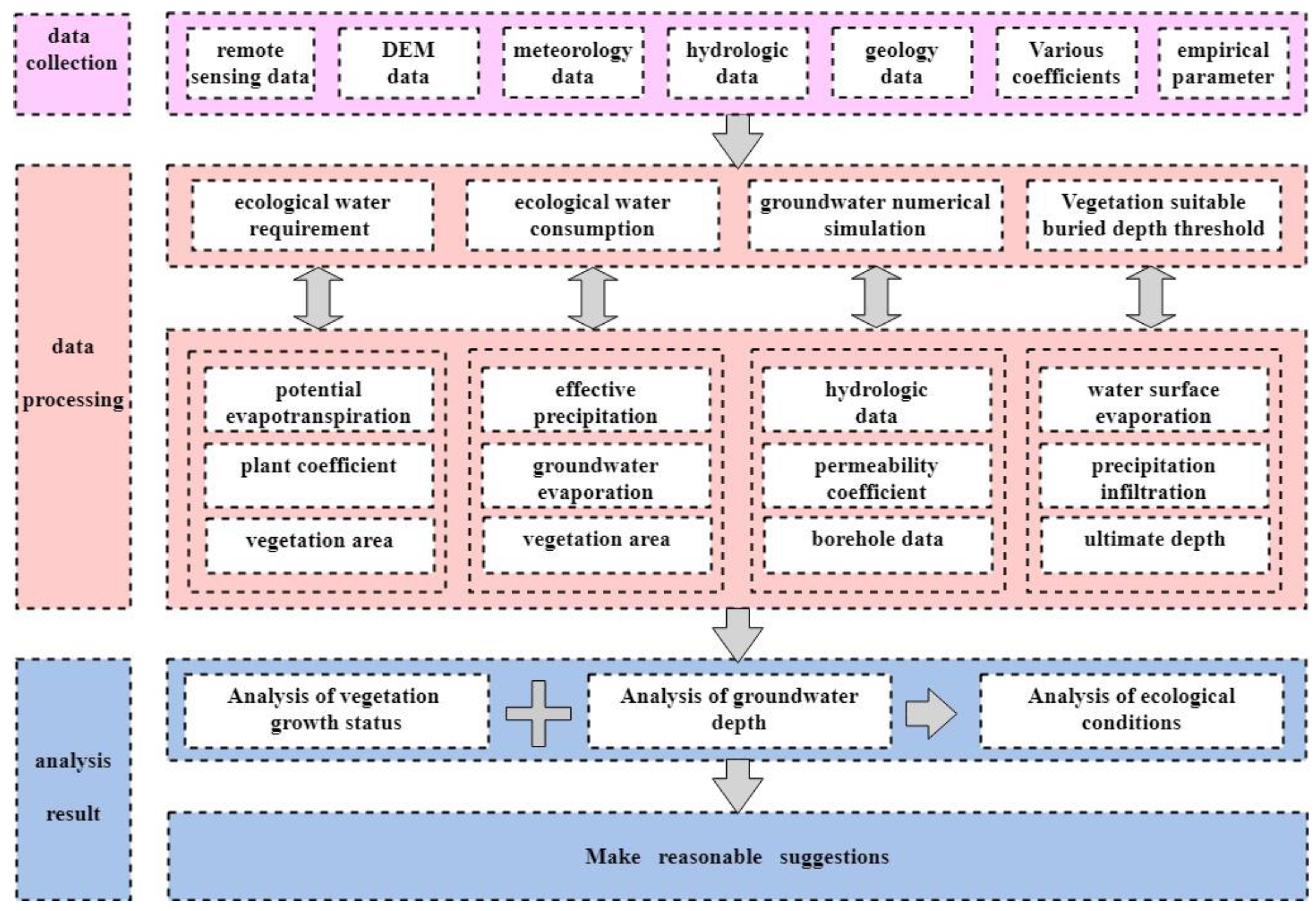
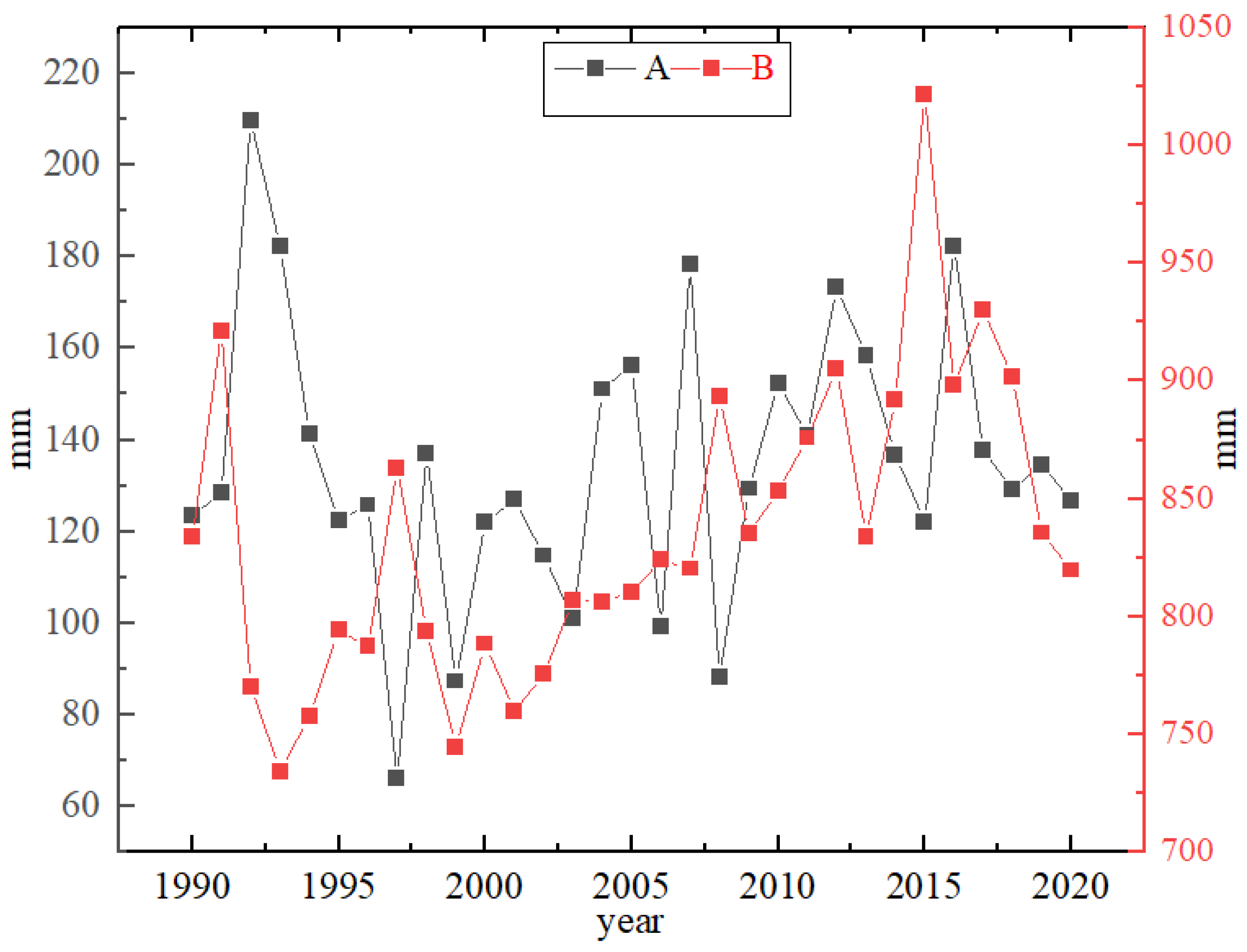

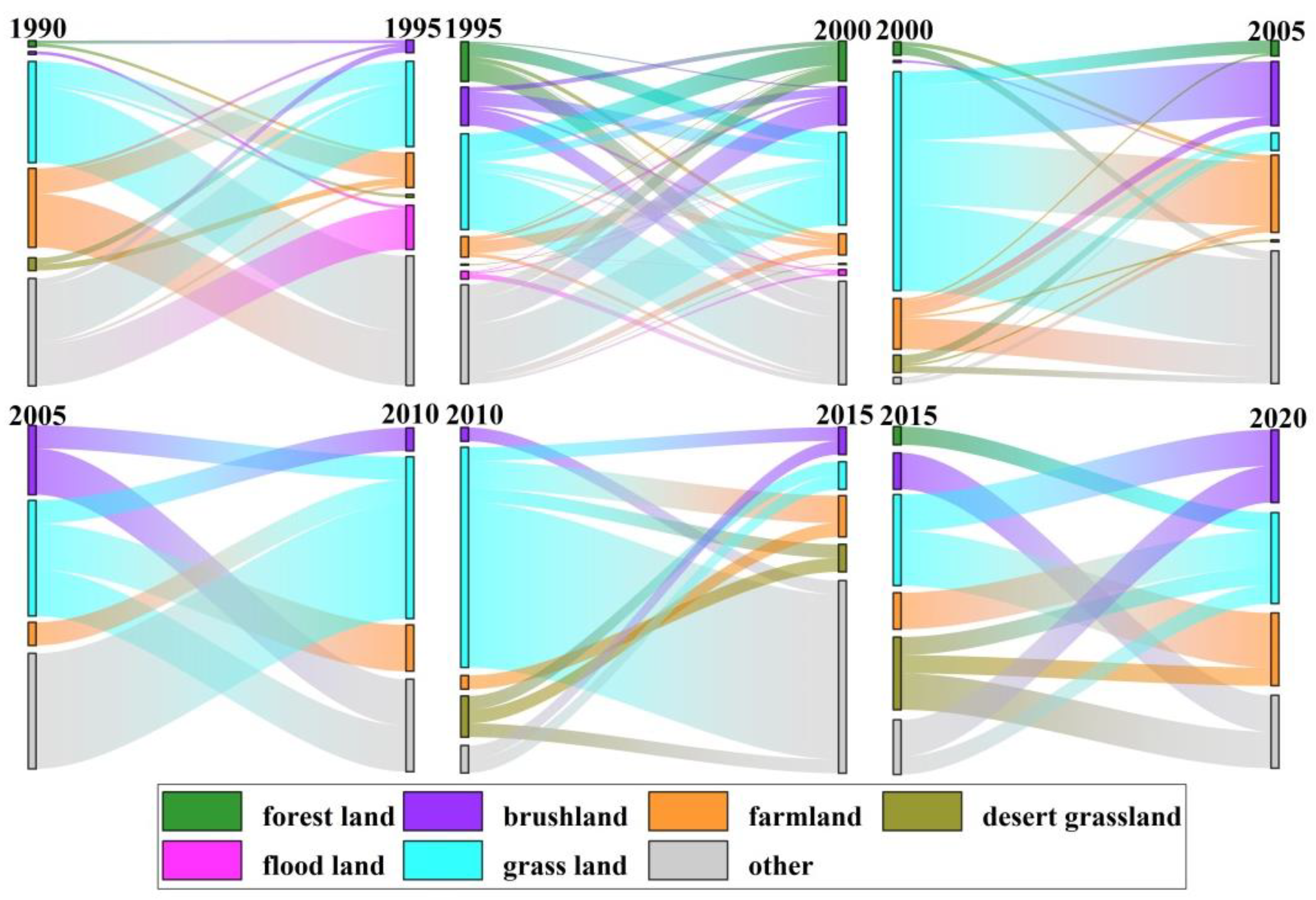
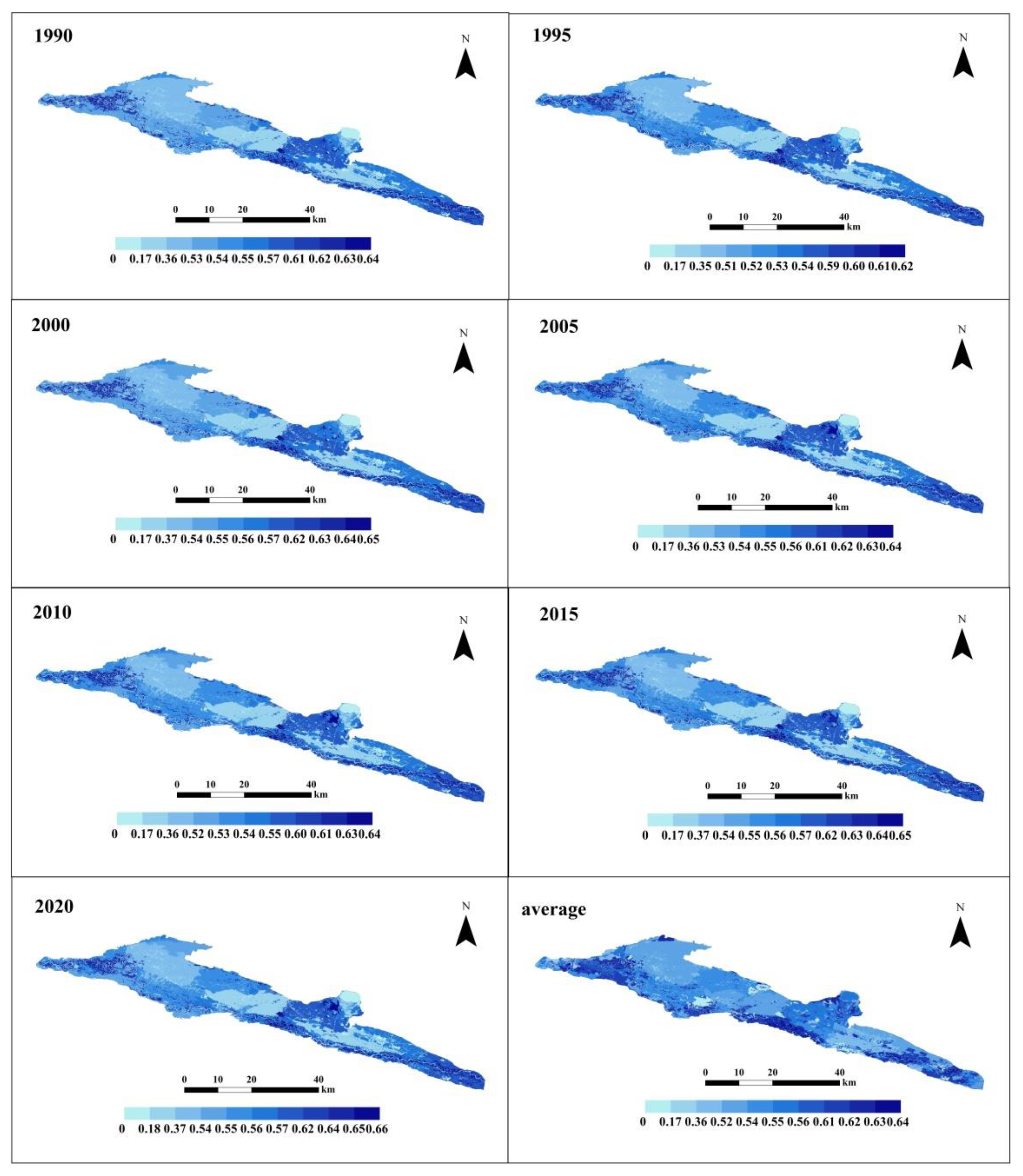
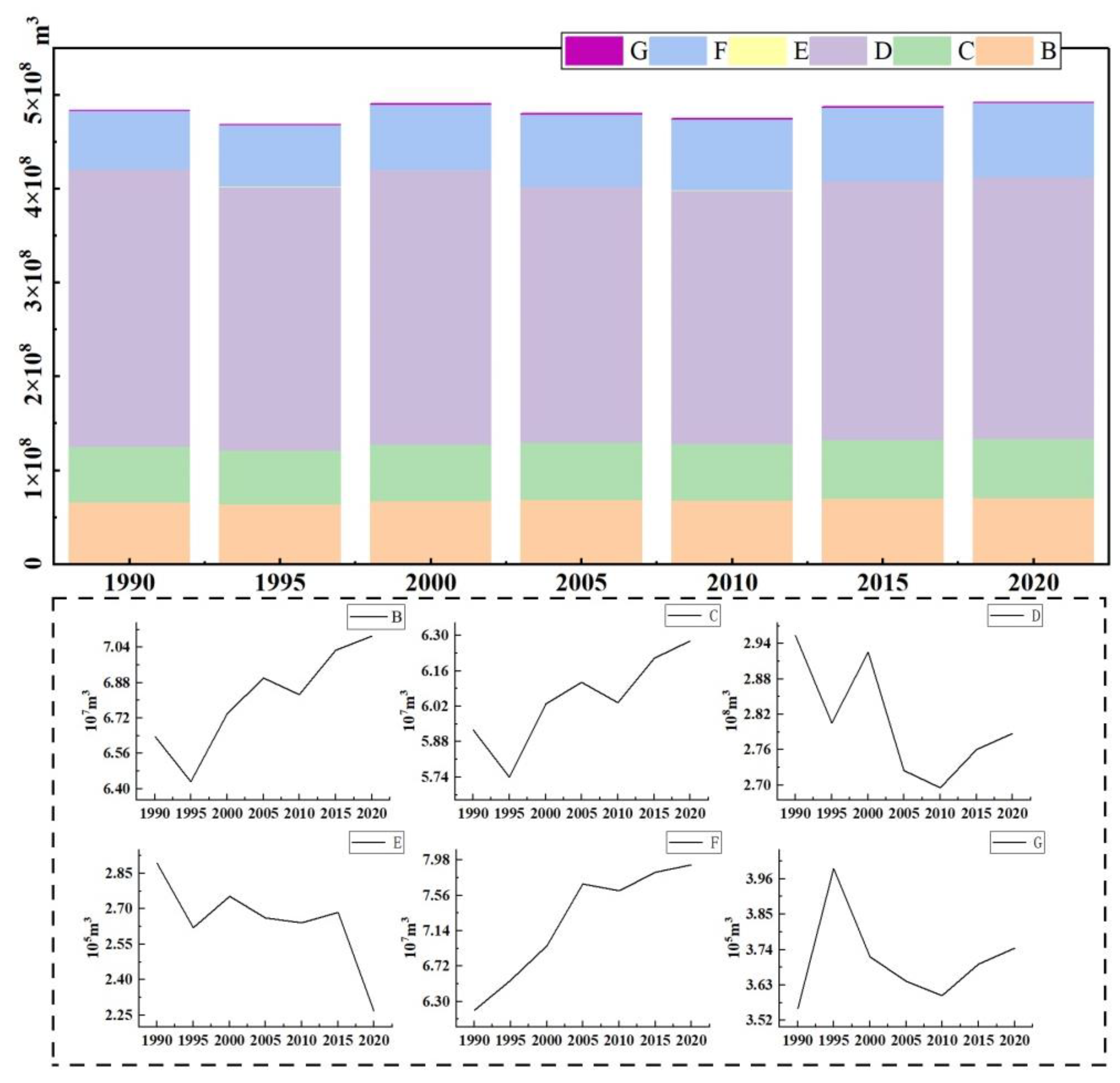

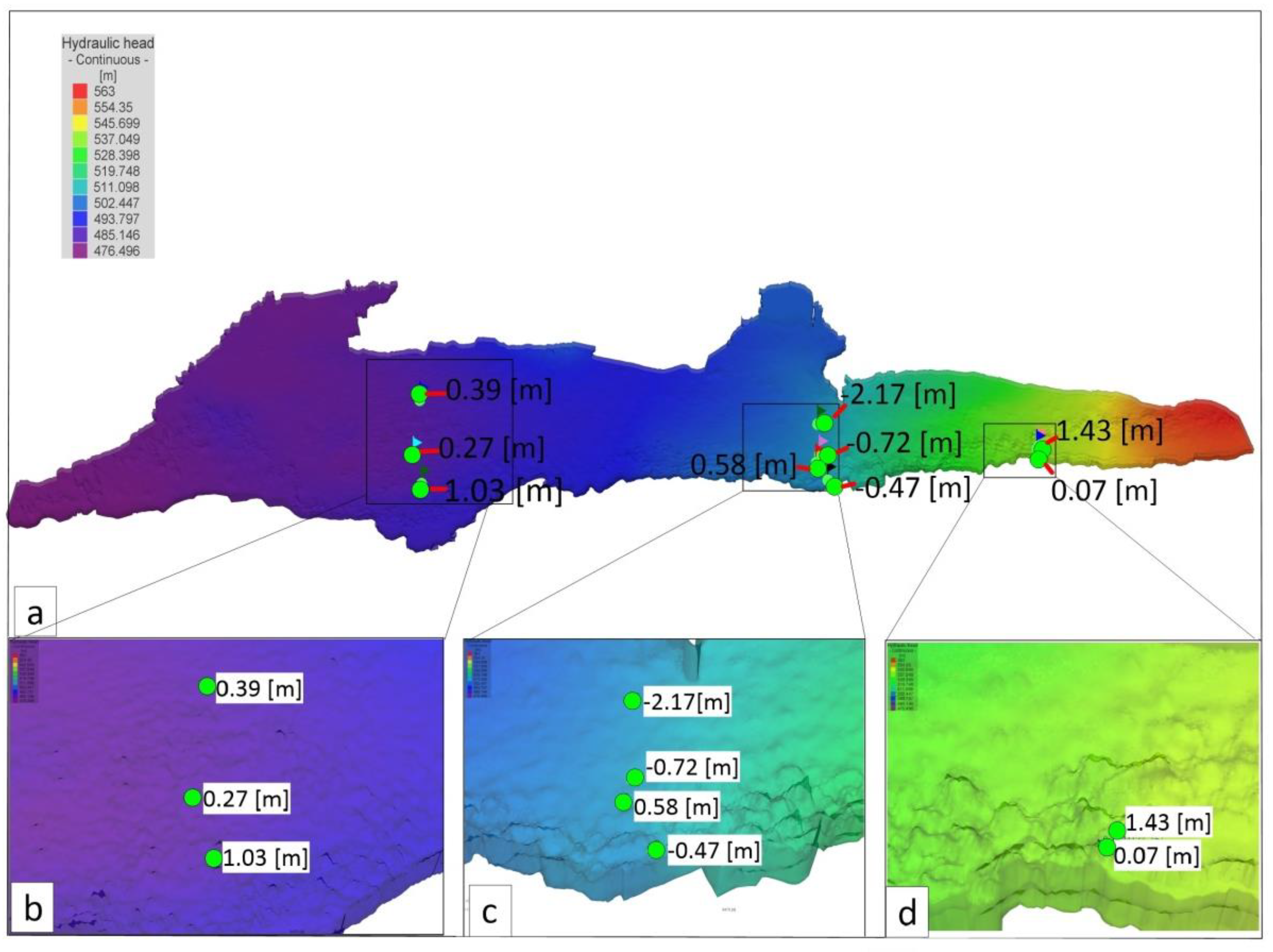
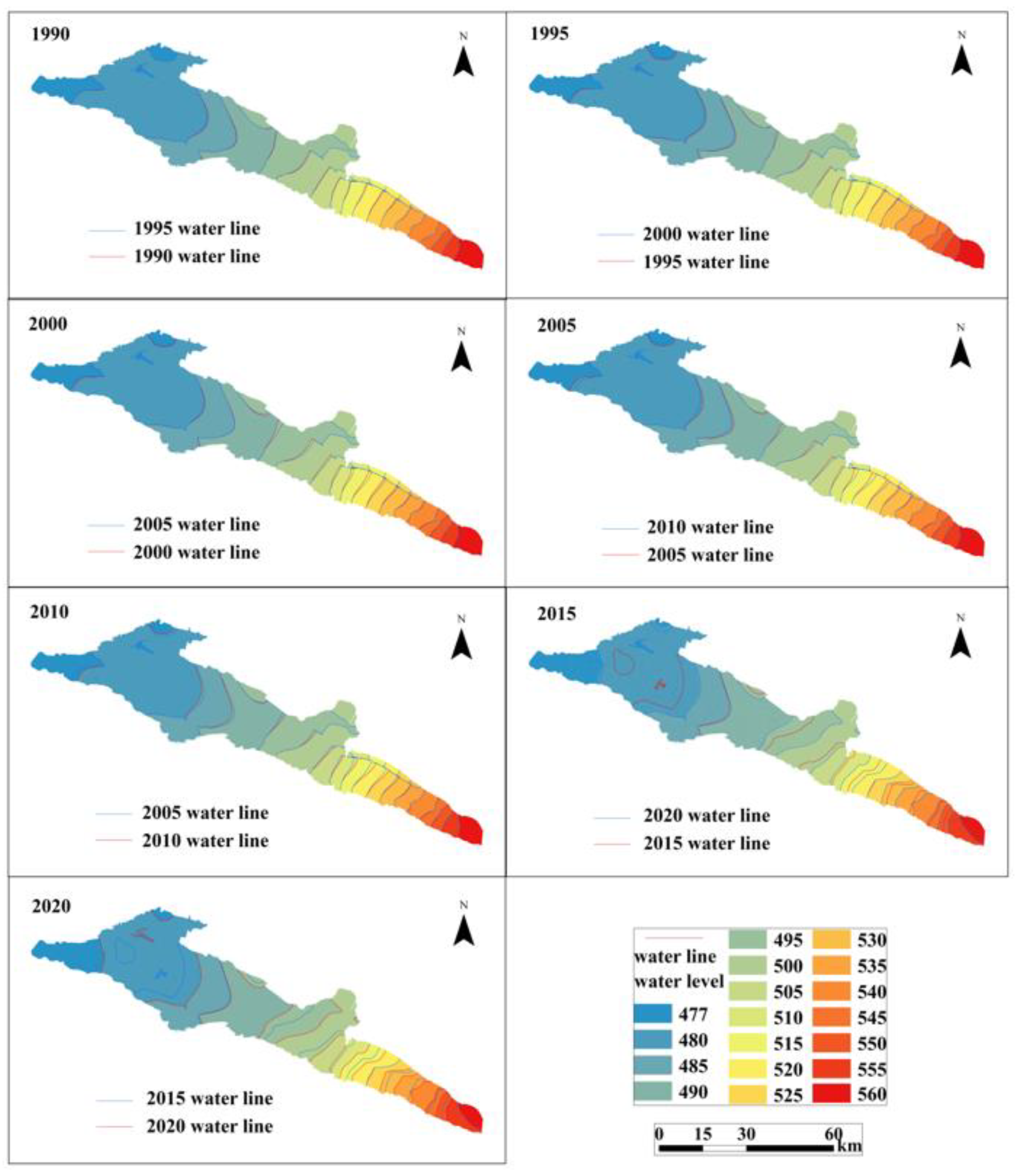

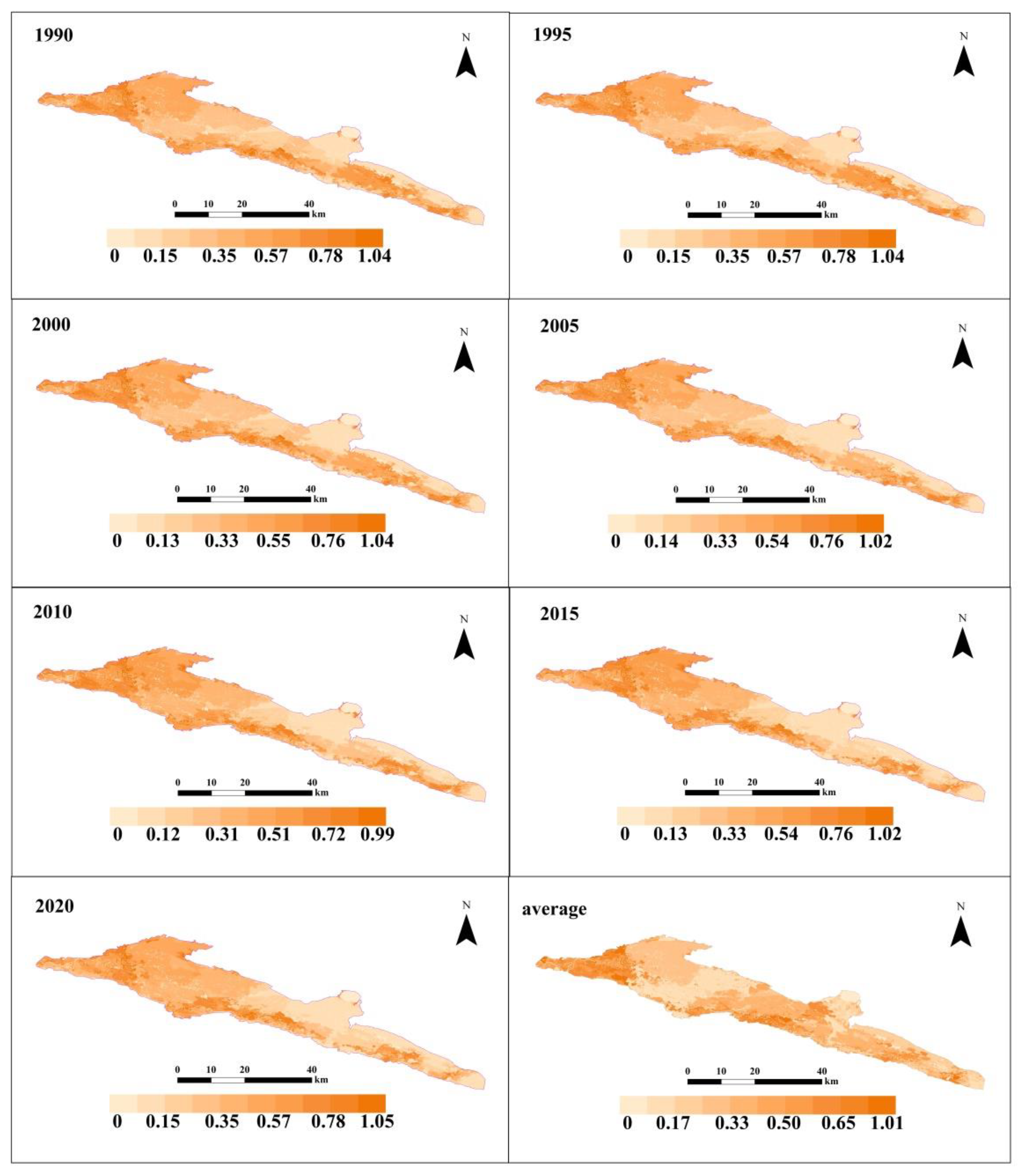

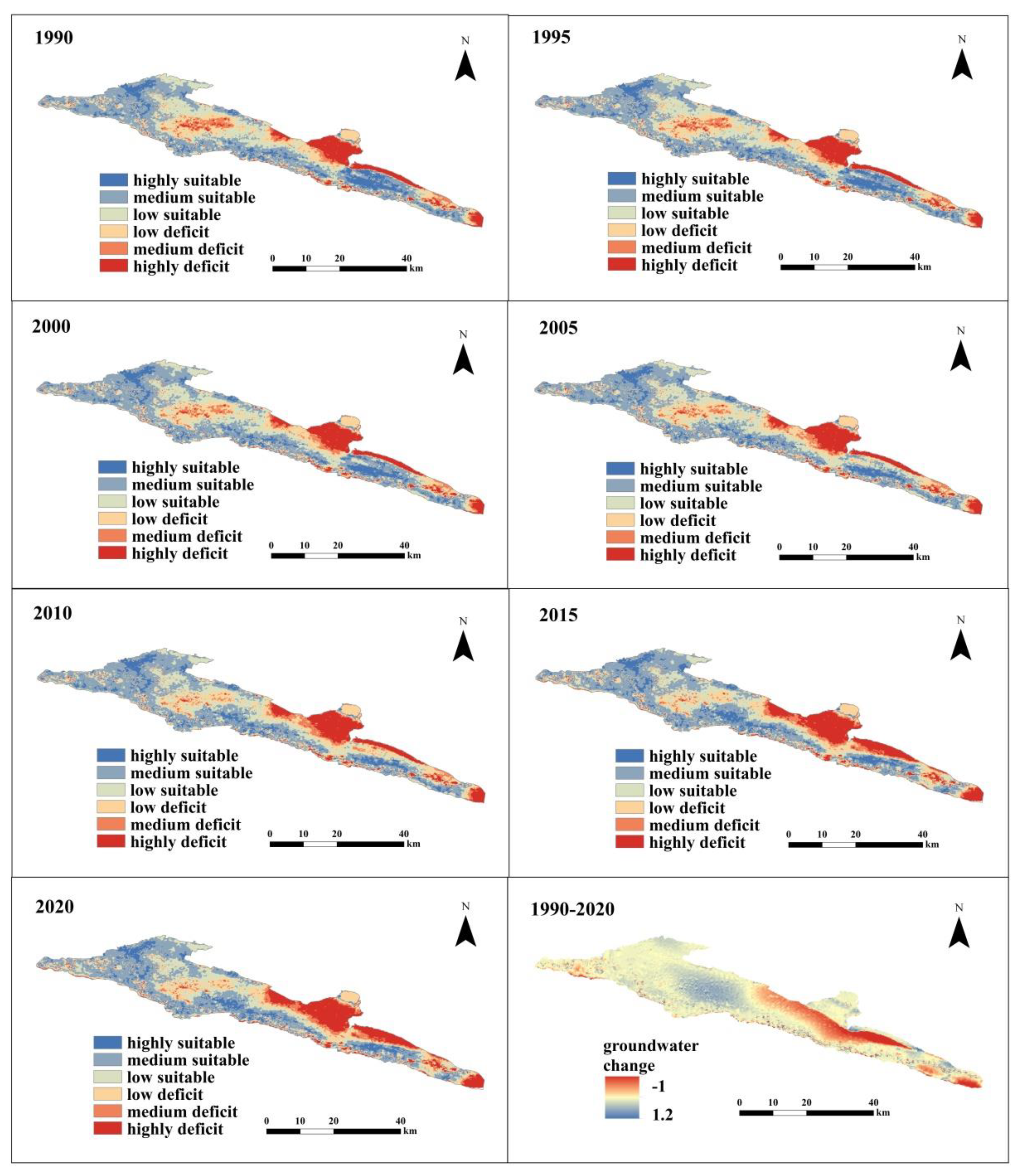

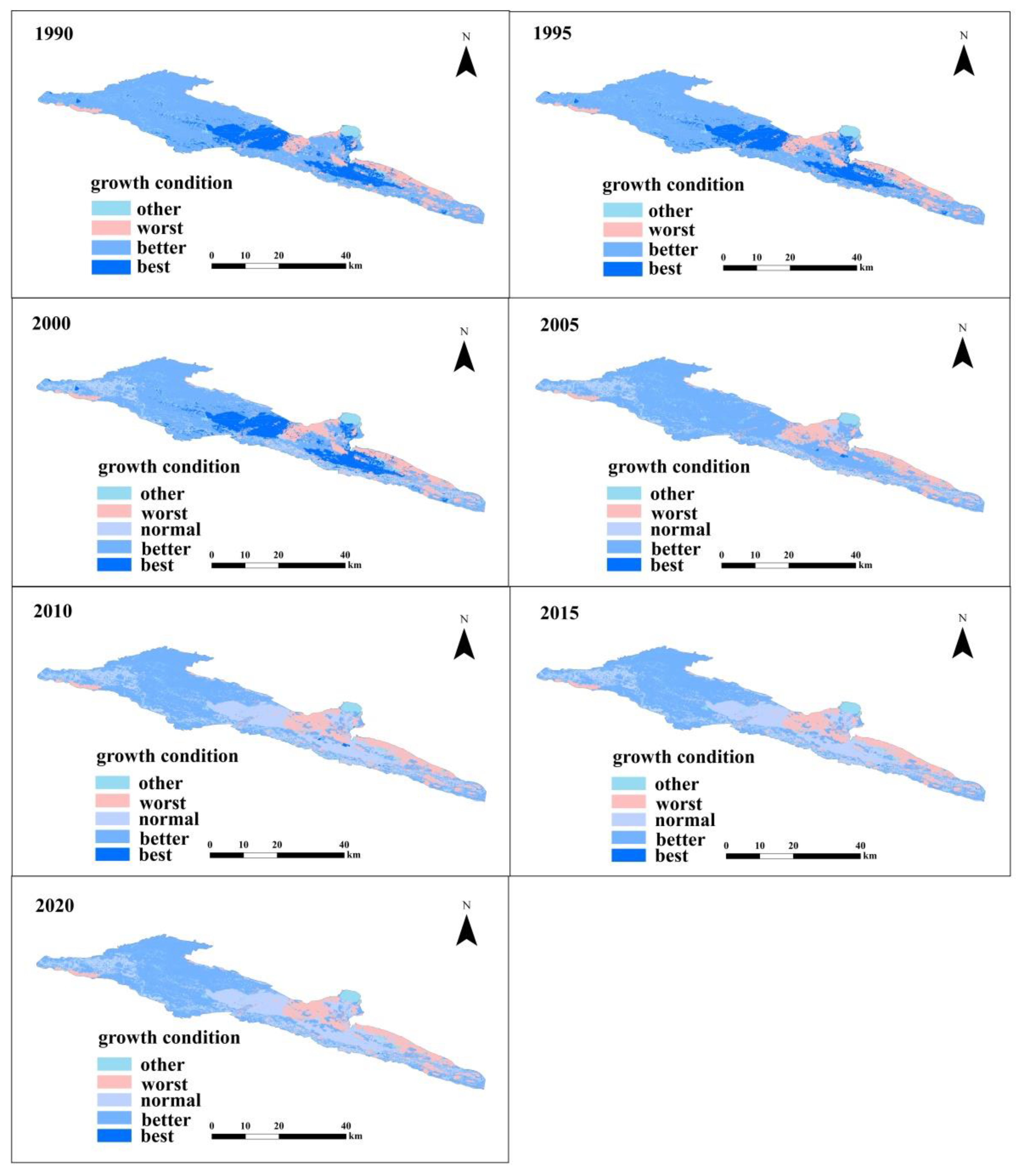
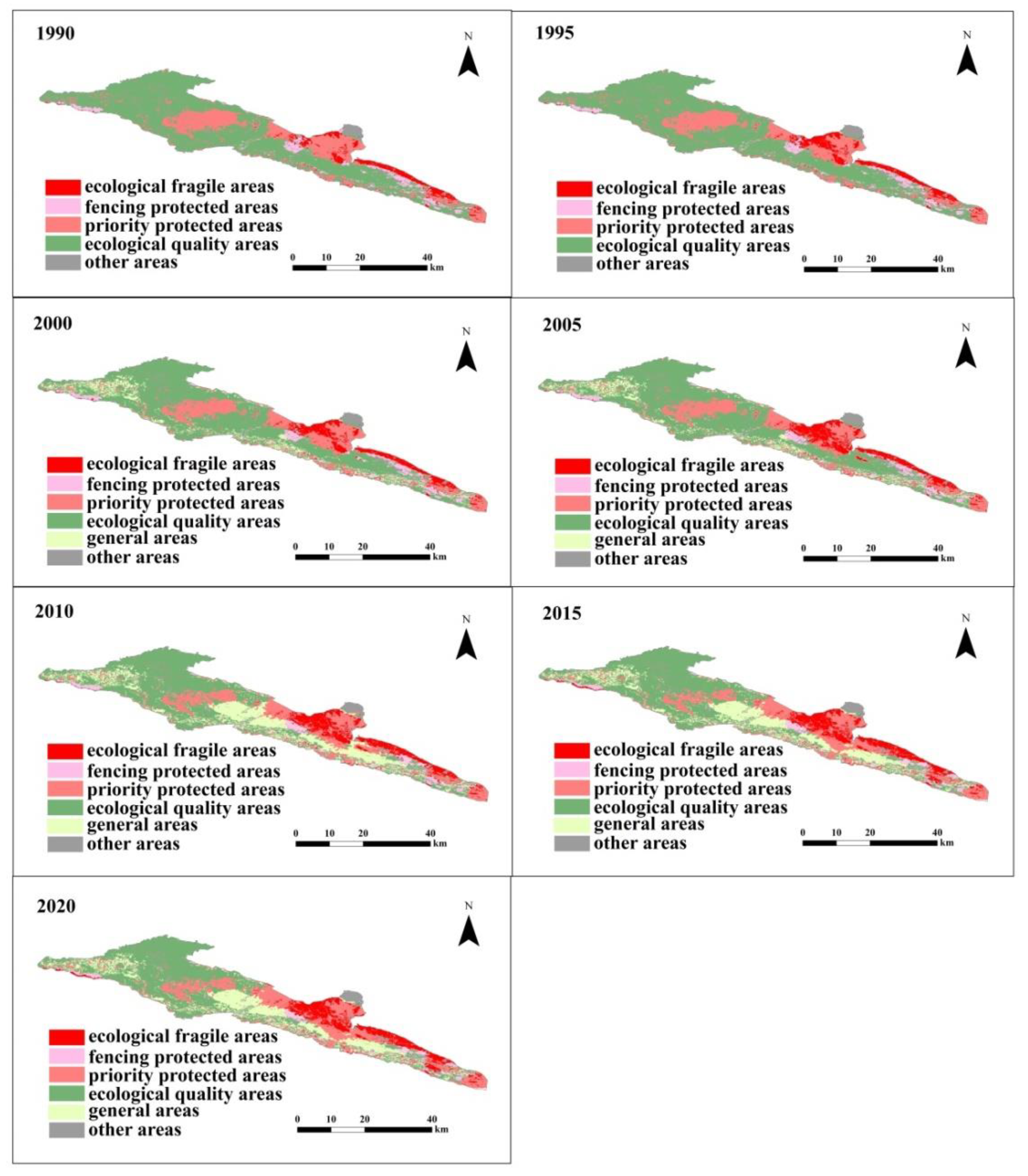
| Month | Forest Land | Brushland | Grassland | Desert Grassland | Farmland | Flood Land |
|---|---|---|---|---|---|---|
| 4 | 0.5 | 0.3 | 0.4 | 0.1 | 0.4 | 0.2 |
| 5 | 0.7 | 0.4 | 0.6 | 0.2 | 0.6 | 0.3 |
| 6 | 0.9 | 0.5 | 0.8 | 0.25 | 0.8 | 0.35 |
| 7 | 1.1 | 0.6 | 0.9 | 0.3 | 0.9 | 0.4 |
| 8 | 0.8 | 0.5 | 0.8 | 0.25 | 0.8 | 0.35 |
| 9 | 0.6 | 0.4 | 0.6 | 0.2 | 0.6 | 0.3 |
| 10 | 0.5 | 0.3 | 0.4 | 0.1 | 0.4 | 0.2 |
| Annual Average | Forest Land | Brushland | Grassland | Desert Grassland | Farmland | Flood Land |
|---|---|---|---|---|---|---|
| 4 | 42.89 | 26.12 | 33.65 | 8.21 | 34.56 | 17.49 |
| 5 | 92.45 | 53.54 | 77.65 | 25.24 | 79.57 | 40.27 |
| 6 | 145.77 | 81.92 | 126.88 | 38.66 | 130.05 | 57.68 |
| 7 | 154.31 | 85.40 | 123.69 | 39.87 | 126.43 | 56.49 |
| 8 | 92.93 | 58.92 | 90.99 | 27.47 | 93.078 | 40.88 |
| 9 | 44.52 | 30.08 | 43.63 | 14.13 | 44.71 | 22.55 |
| 10 | 18.80 | 11.44 | 14.75 | 3.61 | 15.13 | 7.58 |
| Month | 4 | 5 | 6 | 7 | 8 | 9 | 10 |
|---|---|---|---|---|---|---|---|
| Evaporation capacity | 99.64 | 156.61 | 159.82 | 154.21 | 139.08 | 112 | 59.17 |
| Grade | Highly Suitable | Medium Suitable | Low Suitable | Low Deficit | Medium Deficit | Highly Deficit |
|---|---|---|---|---|---|---|
| Burial depth | ≤−2 | −2–−1 | −1–0 | 0–1 | 1–2 | ≥2 |
| Grade | Water Consumption to Water Demand Ratio (%) | Ecological Significance |
|---|---|---|
| Worst | <60 | Survival constrained |
| Bad | 60–70 | Growth is curbed |
| Normal | 70–80 | Maintain normal growth |
| Better | 80–90 | Growth conditions are good |
| Best | 90–100 | The best condition for growth |
Disclaimer/Publisher’s Note: The statements, opinions and data contained in all publications are solely those of the individual author(s) and contributor(s) and not of MDPI and/or the editor(s). MDPI and/or the editor(s) disclaim responsibility for any injury to people or property resulting from any ideas, methods, instructions or products referred to in the content. |
© 2023 by the authors. Licensee MDPI, Basel, Switzerland. This article is an open access article distributed under the terms and conditions of the Creative Commons Attribution (CC BY) license (https://creativecommons.org/licenses/by/4.0/).
Share and Cite
Dong, X.; Hu, S.; Yuan, Q.; Kou, Y.; Li, S.; Deng, W.; Ren, P. Research on Vegetation Ecological Security in Arid Region Mountain Front River Valleys Based on Ecological Water Consumption and Water Demand. Land 2023, 12, 1642. https://doi.org/10.3390/land12081642
Dong X, Hu S, Yuan Q, Kou Y, Li S, Deng W, Ren P. Research on Vegetation Ecological Security in Arid Region Mountain Front River Valleys Based on Ecological Water Consumption and Water Demand. Land. 2023; 12(8):1642. https://doi.org/10.3390/land12081642
Chicago/Turabian StyleDong, Xiangshou, Shihang Hu, Quanzhi Yuan, Yaowen Kou, Shujun Li, Wei Deng, and Ping Ren. 2023. "Research on Vegetation Ecological Security in Arid Region Mountain Front River Valleys Based on Ecological Water Consumption and Water Demand" Land 12, no. 8: 1642. https://doi.org/10.3390/land12081642




